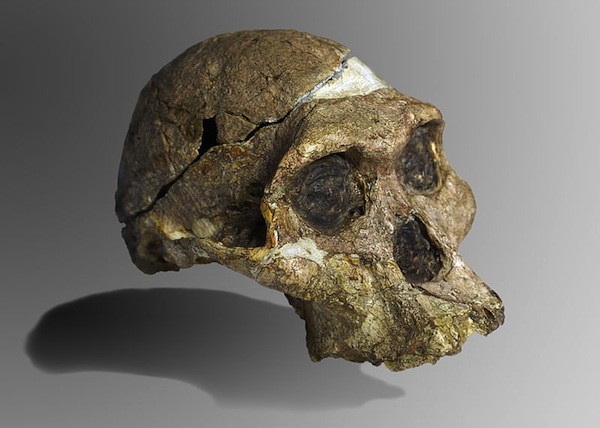
远古人类与现代人类的听力差别
Ancient Human Ancestors Heard Differently
远古人类与现代人类的听力差别
Early human species may have had sharper hearing in certain frequenciesthan we enjoy, to facilitate short-range communication in an open environment.Cynthia Graber reports
在特定频率上,早期人种比我们有着更为敏锐的听觉,这有利于他们在开阔环境中进行短距离的交流。
原文:辛西娅·格莱博(CynthiaGraber)
翻译:王娇娇
审校:张旭阳
2015.10.13
Imagine the evolutionary advantage of being able to hear a predatorrustling in the tall grass nearby—or in the ability to hear a comrade making asound to warn you about that predator. Now a study finds that early humanspecies may have had sharper hearing in certain frequencies than we enjoy. Thefinding is in the journal Science Advances. [Rolf Quam et al, Early homininauditory capacities]
如果能听见野兽在高高的草丛中穿行的窸窣声,或能听见同伴发出的警告声,想象一下这种敏锐听觉在进化上的优势吧。目前有研究表明,早期人类物种在特定的[U1] 频率上可能有着比我们更为敏锐的听力,相关研究结果已发表于期刊Science Advances(Rolf Quam et al,Early hominin auditory capacities.)。
“We’ve been able toreconstruct an aspect of sensory perception in a fossil human ancestor known asAustralopithecus africanus and Paranthropus robustus from South Africa.” BinghamtonUniversity anthropologist Rolf Quam said.“Both of thesefossil forms lived about two million years ago and represent early humanancestors. We took CT scans of the skulls. We created virtual reconstructionson the computer of the internal structures of the ear that will predict how anorganism hears based on these measurements of its ear.”
“我们选择了来自非洲的南方古猿非洲种(Australopithecus africanus)和南方古猿粗壮种(Paranthropus robustus)来重建人类祖先的感官。”宾汉姆顿大学(Binghamton University)的人类学家罗尔夫·夸姆(Rolf Quam)说道,“这些化石形成于200万年前,是早期人类的代表。我们通过CT扫描化石头骨,基于这些测量,我们用电脑对耳朵内部与听力相关的结构进行了可视化重建。”

The original skull (without upper teeth and mandible) of a2.1-million-year-old Australopithecus africanus specimen so-called Mrs. Ples,discovered in South Africa. (José Braga; Didier Descouens via WikimediaCommons)
这个原始头骨(没有上牙和下颌)就是所谓的普莱斯女士(Mrs.Ples),属于南方古猿非洲种人,发现于南非,已有210万年历史.(José Braga;Didier Descouens via Wikimedia Commons)
And the reconstructed physiology reveals that those early homininslikely heard differently than both modern chimps and modern humans. Specifically,the hominins were probably more sensitive to frequencies associated with soundslike t, k, f and s.
重建后的生物数据显示早期类人猿的听觉模式既不同于现代的黑猩猩,也不同于现代人类。具体来说,类人猿很可能对t、k、f和s相关的声音频率更为敏感。
“We’re not arguing they hadlanguage, but we think our results do have implications for how theycommunicated. And the finding is that this hearing pattern would have beenbeneficial if you were engaging in short-range vocal communication in an openenvironment.”
“我们并不是说他们已经有了语言,但是我们的结果确实可以用于推断他们是如何交流的。结果表明在开阔地带,这种听觉模式有利于短距离的声音交流。”
The estimation of the hearing abilities of the hominins complementsprevious research suggesting that these species spent more time in openenvironments such as the savannah—where a hasty, short-range consonant from acomrade might convey important information—than they spent in dense rainforests, where sound travelsfarther. Could be that [consonant sounds] were survival tools that also pavedthe way for the evolution of full-fledged human language. Even if we can’t hearthose sounds quite as well as those ancient hominins did.
先前的研究发现,类人猿在稀树草原类的开阔环境中活动的活动时间要比密集的雨林中长。评估类人猿听力是对此研究的一个补充,因为在开阔地带,声音较雨林中传播距离短,而同伴发出的急促且短程的辅音可能传递了重要信息。尽管我们不能像类人猿那样听到这些音节,但是辅音音节作为一种生存手段,为成熟人类语言的形成铺平了道路。
—Cynthia Graber
——辛西娅·格莱博
[The above text is a transcript of this podcast.]
[Quam audio provided by Casey Staff.]
未经书面许可任何人不得复制或镜像
京ICP备11000850号-1
 京公网安备11010502039775号
京公网安备11010502039775号 信息网络传播视听节目许可证0111611号
国家科技基础条件平台

















